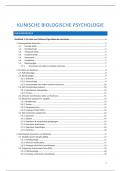Samenvatting
Samenvatting klinisch biologisch psychologie (2024)
Dit is een uitgebreide samenvatting van het vak klinisch biologische psychologie gegeven in de eerste master klinisch psychologie aan de VUB. De samenvatting omvat alle informatie van de slides, lesnota's en afbeeldingen.
[Meer zien]
Voorbeeld 6 van de 82 pagina's
Geupload op
18 april 2024
Aantal pagina's
82
Geschreven in
2023/2024
Type
Samenvatting
€6,36
100% tevredenheidsgarantie
Direct beschikbaar na betaling
Zowel online als in PDF
Je zit nergens aan vast
KLINISCHE BIOLOGISCHE PSYCHOLOGIE




